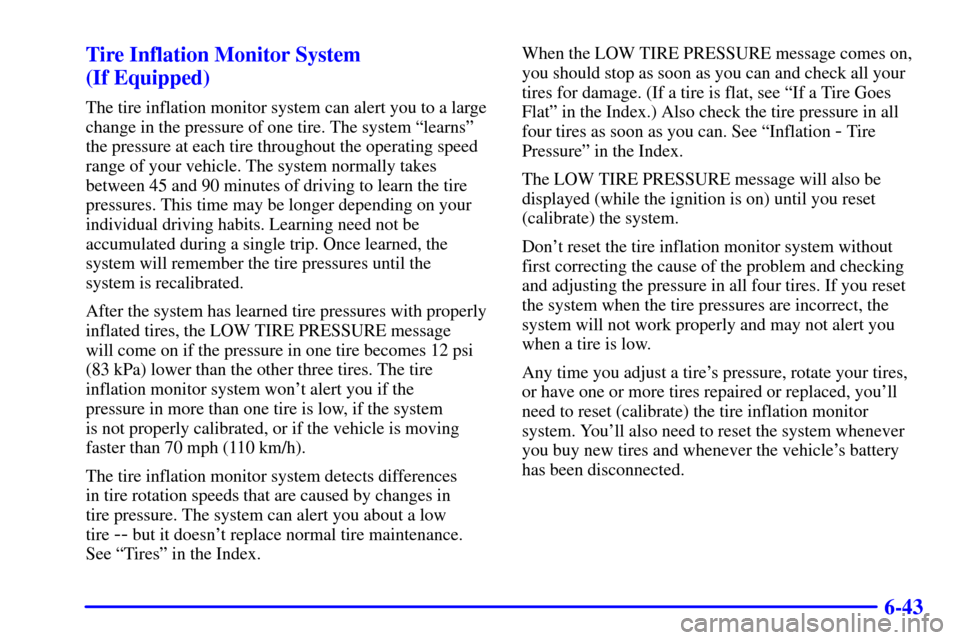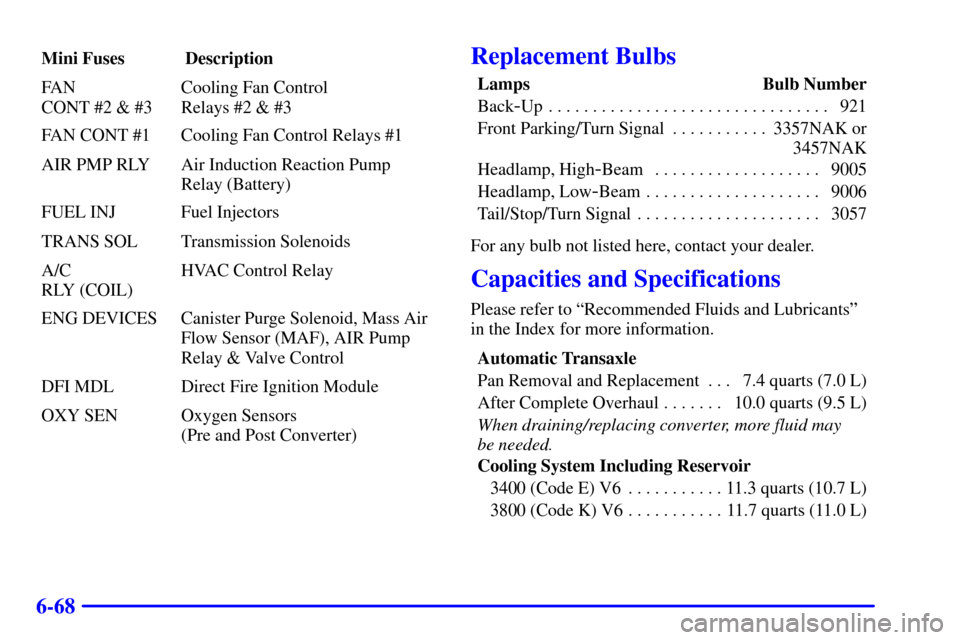Page 323 of 397

6-34 Replacing Brake System Parts
The braking system on a vehicle is complex. Its many
parts have to be of top quality and work well together if
the vehicle is to have really good braking. Your vehicle
was designed and tested with top
-quality GM brake parts.
When you replace parts of your braking system
-- for
example, when your brake linings wear down and you
need new ones put in
-- be sure you get new approved
GM replacement parts. If you don't, your brakes may no
longer work properly. For example, if someone puts in
brake linings that are wrong for your vehicle, the balance
between your front and rear brakes can change
-- for the
worse. The braking performance you've come to expect
can change in many other ways if someone puts in the
wrong replacement brake parts.
Battery
Your new vehicle comes with a maintenance free
ACDelco� battery. When it's time for a new battery,
get one that has the replacement number shown on the
original battery's label. We recommend an ACDelco
battery. See ªEngine Compartment Overviewº in the
Index for battery location.WARNING: Battery posts, terminals and related
accessories contain lead and lead compounds, chemicals
known to the State of California to cause cancer and
reproductive harm. Wash hands after handling.
Vehicle Storage
If you're not going to drive your vehicle for 25 days
or more, remove the black, negative (
-) cable from
the battery. This will help keep your battery from
running down.
CAUTION:
Batteries have acid that can burn you and gas
that can explode. You can be badly hurt if you
aren't careful. See ªJump Startingº in the Index
for tips on working around a battery without
getting hurt.
Contact your dealer to learn how to prepare your vehicle
for longer storage periods.
Also, for your audio system, see ªTheft
-Deterrent
Featureº in the Index.
Page 332 of 397

6-43 Tire Inflation Monitor System
(If Equipped)
The tire inflation monitor system can alert you to a large
change in the pressure of one tire. The system ªlearnsº
the pressure at each tire throughout the operating speed
range of your vehicle. The system normally takes
between 45 and 90 minutes of driving to learn the tire
pressures. This time may be longer depending on your
individual driving habits. Learning need not be
accumulated during a single trip. Once learned, the
system will remember the tire pressures until the
system is recalibrated.
After the system has learned tire pressures with properly
inflated tires, the LOW TIRE PRESSURE message
will come on if the pressure in one tire becomes 12 psi
(83 kPa) lower than the other three tires. The tire
inflation monitor system won't alert you if the
pressure in more than one tire is low, if the system
is not properly calibrated, or if the vehicle is moving
faster than 70 mph (110 km/h).
The tire inflation monitor system detects differences
in tire rotation speeds that are caused by changes in
tire pressure. The system can alert you about a low
tire
-- but it doesn't replace normal tire maintenance.
See ªTiresº in the Index.When the LOW TIRE PRESSURE message comes on,
you should stop as soon as you can and check all your
tires for damage. (If a tire is flat, see ªIf a Tire Goes
Flatº in the Index.) Also check the tire pressure in all
four tires as soon as you can. See ªInflation
- Tire
Pressureº in the Index.
The LOW TIRE PRESSURE message will also be
displayed (while the ignition is on) until you reset
(calibrate) the system.
Don't reset the tire inflation monitor system without
first correcting the cause of the problem and checking
and adjusting the pressure in all four tires. If you reset
the system when the tire pressures are incorrect, the
system will not work properly and may not alert you
when a tire is low.
Any time you adjust a tire's pressure, rotate your tires,
or have one or more tires repaired or replaced, you'll
need to reset (calibrate) the tire inflation monitor
system. You'll also need to reset the system whenever
you buy new tires and whenever the vehicle's battery
has been disconnected.
Page 352 of 397
6-63
Mini Fuses Description
CIG/AUX Accommodated
Device (Accessory)
BCM Body Control Module (Accessory)
SRS Supplemental Restraint System
ABS/PCM Anti
-Lock Brake System,
Powertrain Control Module, Brake
Switch, Crank Relay, Canister
Vent Solenoid (Run, Crank)
STOP Brake Lamps, Body Control
Module (Run, Crank)
TURN SIGNAL Turn Signal Flashers
CRUISE Cruise Control Steering
Column Controls
AC/CRUISE HVAC Temp Door Motors &
Module, Cruise Control Module
A/C FAN HVAC Blower
STR COL Steering Wheel LightingMini Fuses Description
DR LK Body Control Module,
Door Lock Controls
PWR MIR Power Mirrors
CLSTR/BCM Cluster, Body Control Module,
Data Link Connector (Battery),
TrapAlert � System
LH HTD
ST/BCMDriver's Heated Seat, Body
Control Module, Battery
Controlled Loads
Circuit Breaker Description
RETAINED
ACCESSORY
PWR BRKRPower Window, Sunroof Breaker
Circuit Relay Description
HEADLAMP
RELAYHeadlamp Relay
RETAINED
ACCESSORY
PWR RELAYRetained Accessory Power Relay
Page 354 of 397
6-65
Mini Fuses Description
TRK/
ROOF BRPTrunk Lamps, Headliner Lamps
HVAC BLO HVAC Blower Relay
I/P BRP Instrument Panel Footwell Lamps,
Glovebox Lamps
HTD MIR Heated Mirrors
BRK SW Brake Switch
HAZ SW Hazard Switch
REAR PRK LP Rear Parking Lamps
AUX PWR Accessory Power Outlet (Battery)
C/LTR Cigarette Lighter
RADIO Radio, Radio Amplifier
FRT PARK LP Front Parking Lamps,
Instrumentation Lighting Circuit Relay Description
PARK
LP RELAYParking Lamp Relay
BACK UP
LP RELAYBack
-up Lamps Relay
BATT RUN
DOWN
PROTECTION
RELAYBattery Run Down
Protection Relay
REAR
DEFOG RELAYRear Defogger Relay,
Heated Mirror Relay
Circuit Breaker Description
POWER
SEATS BRKRPower Seat Circuit Breaker
REAR
DEFOG BRKRRear Defogger Breaker
Page 355 of 397
6-66
Underhood Fuse Block (Upper)
Some fuses are in a fuse block in the engine
compartment on the passenger's side of the vehicle.
See ªEngine Compartment Overviewº in the Index
for more information on location.
Circuit Relay Description
FUEL PUMP Fuel Pump
DRL RELAY Daytime Running Lamps
A.I.R. RELAY Air Induction Reaction Relay
CRANK RLY Starter (Crank) RelayCircuit Relay Description
HORNS Horn
FOG LTS Fog Lamps
Maxi Fuses Description
LEFT I/P Left Fuse Block (Battery)
RT I/P #1 Right Fuse Block (Battery)
RT I/P #2 Right Fuse Block (Battery)
U/HOOD #1 Underhood (Top) Fuse Block
Mini Fuses Description
HORN RLY Horn Relay
BLANK Blank
BLANK Blank
FOG RLY Fog Lamps Relay
F/PMP RLY Fuel Pump Relay
DRL/EXIT LTS Low (Left Front) & High
(Left Front) Headlamps
EXT LTS Low (Right Front) & High
(Right Front) Headlamps
PCM PCM Battery
A/C RLY
(CMPR)HVAC Compressor
Relay & Generator
Page 356 of 397
6-67
Underhood Fuse Block (Lower)
Some fuses are in a fuse block in the engine
compartment on the passenger's side of the vehicle.
See ªEngine Compartment Overviewº in the Index
for more information on location.Circuit Relay Description
FAN CONT #3 Secondary Cooling Fan
(Passenger's Side)
FAN CONT #2 Cooling Fan Control Relay
FAN CONT #1 Primary Cooling Fan
(Driver's Side)
IGN RELAY Ignition Relay
A/C CMPR HVAC Compressor
Maxi Fuses Description
IGN SW Ignition Switch
RT I/P #3 Rear Defogger, Audio System
U/HOOD #2 Ignition Relay, AIR Pump
COOLING
FANSCooling Fans (Battery)
Page 357 of 397

6-68
Mini Fuses Description
FAN
CONT #2 & #3Cooling Fan Control
Relays #2 & #3
FAN CONT #1 Cooling Fan Control Relays #1
AIR PMP RLY Air Induction Reaction Pump
Relay (Battery)
FUEL INJ Fuel Injectors
TRANS SOL Transmission Solenoids
A/C
RLY (COIL)HVAC Control Relay
ENG DEVICES Canister Purge Solenoid, Mass Air
Flow Sensor (MAF), AIR Pump
Relay & Valve Control
DFI MDL Direct Fire Ignition Module
OXY SEN Oxygen Sensors
(Pre and Post Converter)Replacement Bulbs
Lamps Bulb Number
Back
-Up 921. . . . . . . . . . . . . . . . . . . . . . . . . . . . . . . .
Front Parking/Turn Signal 3357NAK or. . . . . . . . . . .
3457NAK
Headlamp, High
-Beam 9005. . . . . . . . . . . . . . . . . . .
Headlamp, Low
-Beam 9006. . . . . . . . . . . . . . . . . . . .
Tail/Stop/Turn Signal 3057. . . . . . . . . . . . . . . . . . . . .
For any bulb not listed here, contact your dealer.
Capacities and Specifications
Please refer to ªRecommended Fluids and Lubricantsº
in the Index for more information.
Automatic Transaxle
Pan Removal and Replacement 7.4 quarts (7.0 L). . .
After Complete Overhaul 10.0 quarts (9.5 L). . . . . . .
When draining/replacing converter, more fluid may
be needed
.
Cooling System Including Reservoir
3400 (Code E) V6 11.3 quarts (10.7 L). . . . . . . . . . .
3800 (Code K) V6 11.7 quarts (11.0 L). . . . . . . . . . .